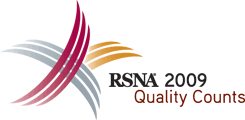
Abstract Archives of the RSNA, 2009
Gaiane M. Rauch MD, PhD, Presenter: Nothing to Disclose
Basak Erguvan Dogan MD, Abstract Co-Author: Nothing to Disclose
Ping Liu, Abstract Co-Author: Nothing to Disclose
Asegul A. Sahin MD, Abstract Co-Author: Nothing to Disclose
Kelly K. Hunt MD, Abstract Co-Author: Nothing to Disclose
Wei Tse Yang MD, Abstract Co-Author: Nothing to Disclose
The aim of this study was to correlate MR-guided 9-gauge vacuum-assisted breast biopsy (MRVAB) histology with surgical histology to determine the upgrade rate, and to correlate the frequency of cancer diagnosis using MRVAB with breast MRI indications and enhancement characteristics of targeted lesions.
A database search was performed of all MRVAB performed in a single institution from January 1, 2007 to December 31, 2008. The clinical indications for breast MRI, patient history, age, risk factors, lesion size, and enhancement characteristics including morphology and time-intensity kinetics were documented. MRVAB pathology was compared with histology at surgery and/or follow up. Fisher’s exact test was used for statistical analysis.
A total of 92 MRVABs were performed in 81 women. Mean patient age was 52 years, range, 28 to 76 years. Mean lesion size was 1.6 cm, range, 0.3 to 8 cm. There were 18 (20%) malignant, 58 (63%) benign, and 16 (17%) high-risk lesions. Surgery was performed in 36/93 (39%) lesions; there were 22 (55%) malignant, 10 (28%) benign, and 6 (17%) high-risk lesions. The upgrade rate to malignancy at surgery was 6/36 (17 %). The frequency of malignancy was higher in diagnostic (77/92, 84%) versus screening (15/92, 16%, p<0.05) MRI patients. Cancer was diagnosed in 8/24 (33%) patients with ipsilateral cancer, 2/20 (10%) patients with contralateral cancer, and 3/11 (27%) patients with a remote history of breast cancer. Highest rate of malignancy by morphologic features was in nonmass-like lesions (12/34, 35%), which showed ductal carcinoma in situ (DCIS) (n=5), DCIS with invasive ductal cancer (IDC)(n=3), invasive lobular cancer (ILC) (n=2, ), and IDC (n=2). Nonmass-like lesions were larger (mean size, 2.8 cm) than mass-like lesions (mean size, 1 cm), p<0.001. The frequency of malignancy was higher in lesions with washout kinetics presenting as nonmass-like lesions (5/11, 45%) or an irregular mass (4/9, 44%).
The malignancy rate in our MRVAB population was 23% with final upgrade rate 17%. The frequency of malignancy was higher in the diagnostic group, and in nonmass-like lesions that often showed DCIS or ILC.
Women who present with cancer, and with nonmass-like lesions that are frequently occult on mammography and ultrasound, have the highest rate of malignancy at MRVAB.
Rauch, G,
Dogan, B,
Liu, P,
Sahin, A,
Hunt, K,
Yang, W,
Outcome Analysis of 9-gauge MRI-guided Vacuum-assisted Breast Biopsies. Radiological Society of North America 2009 Scientific Assembly and Annual Meeting, November 29 - December 4, 2009 ,Chicago IL.
http://archive.rsna.org/2009/8002560.html

